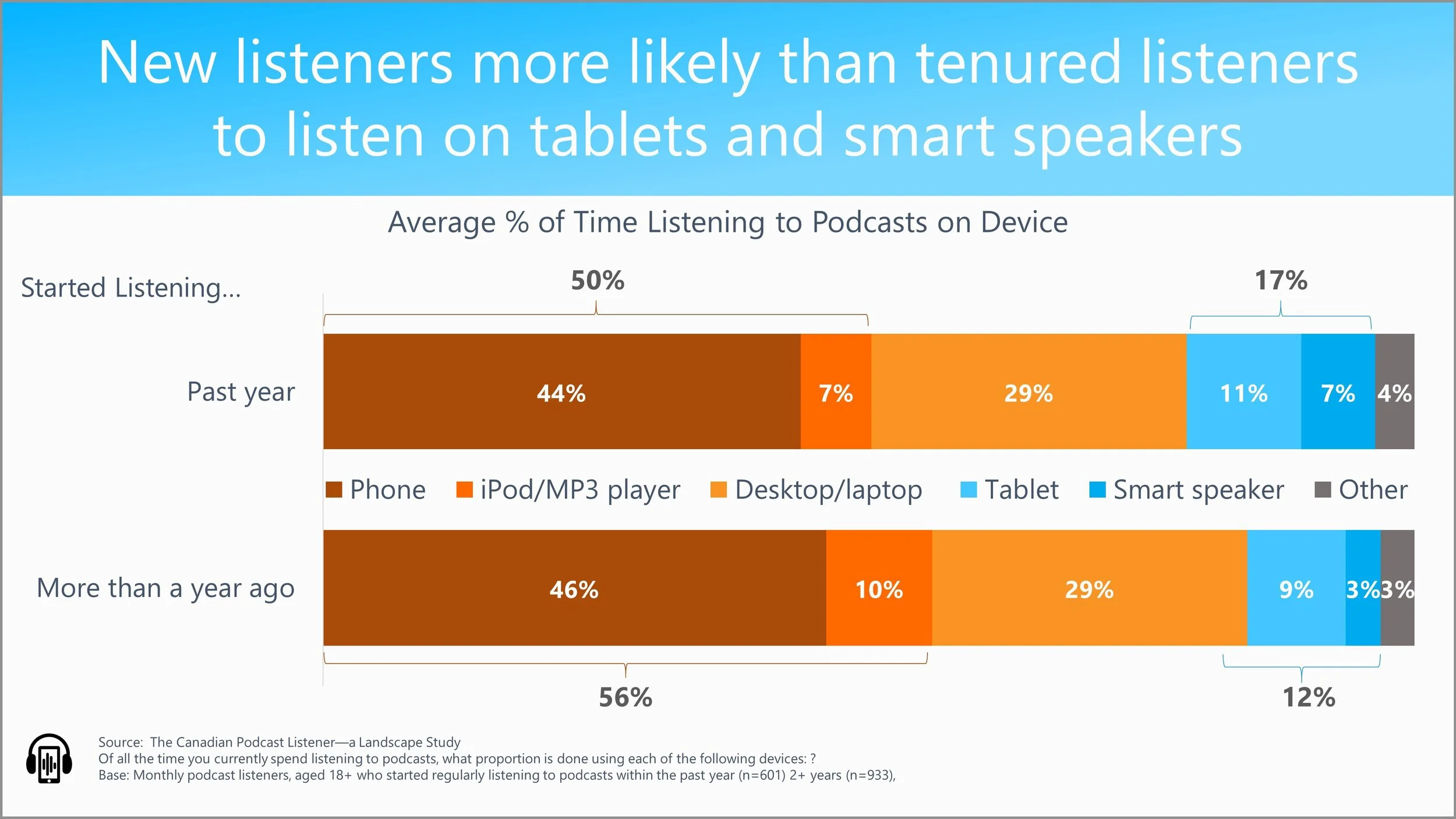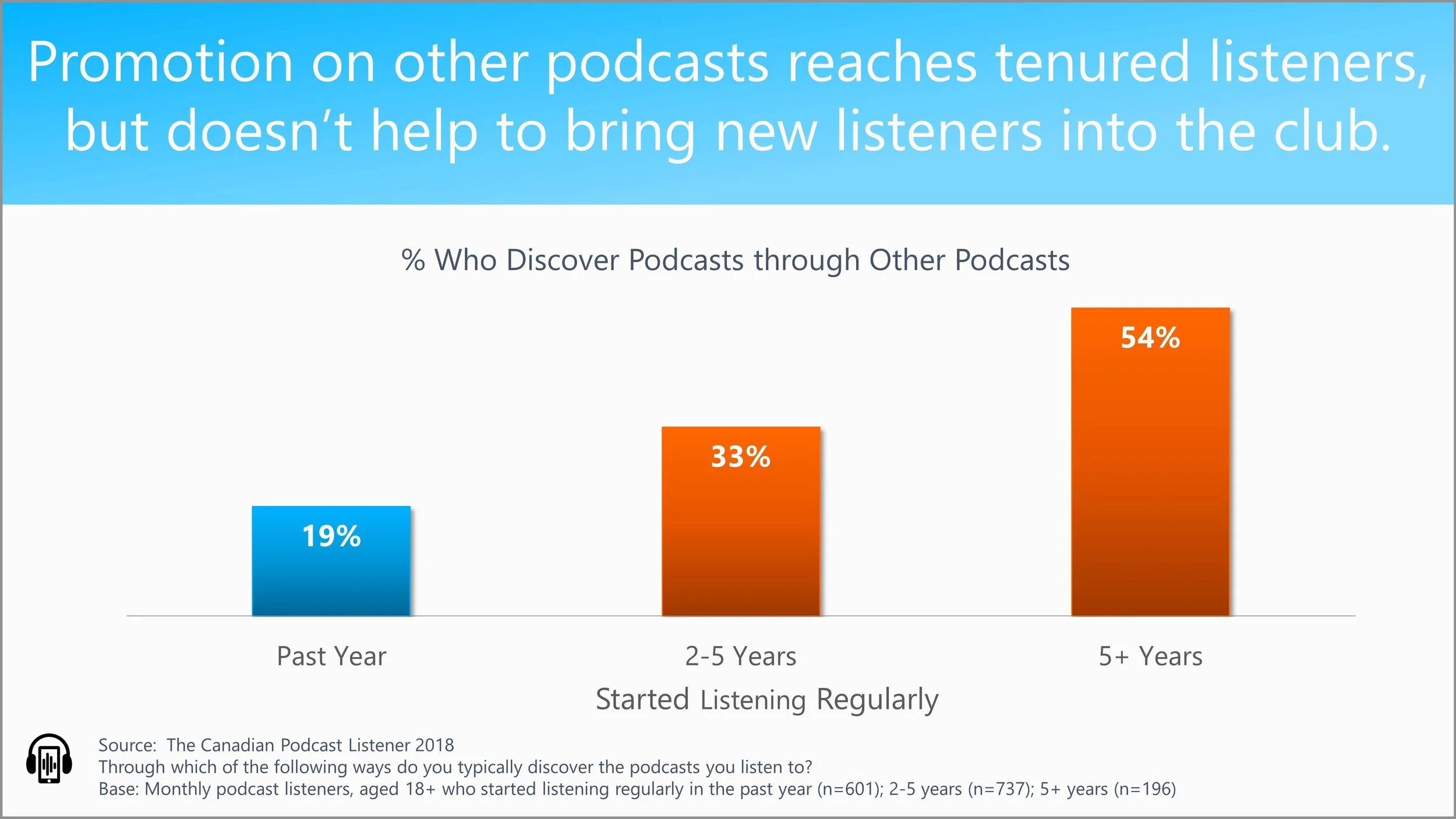Breaking Down the Doors to the Podcasting Club
There’s always been a bit of a clubby aspect to podcasting — certain “rules” of admission that, however unintended, might otherwise seem designed to keep podcast listening the preserve of the true believers. Even the name “podcasting” can be confusing to the unconverted. Do I need an iPod? Where can I find podcasts? Do I need a special app? A subscription — how much does that cost? Why would I listen? The list goes on.
Crunching the data from the second year of The Canadian Podcast Listener, we see some signs of how those rules and misperceptions may be limiting the growth of podcasting. And we see opportunities to open the doors wider to fuel greater growth in the industry.
Let’s start with a little background on The Canadian Podcast Listener. Our study is unique in a couple of ways.
First, it’s an in-depth study of 1,500+ podcast listeners, a big enough sample to get a deep look into different types of podcast listeners.
Second, the survey asks podcast listeners to tell us up to 10 podcasts they’ve listened to in the past month as well as their favourite podcasts. That gives us insight into what people actually listen to as opposed to what they download. Even more important, we get to see how podcast listening varies by different types of listeners — by things like how long they have been a podcast listener.
Here’s what we have learned:
Most podcast growth is coming from listeners inside the club, not those knocking on the door.
The universe of podcast listeners — the people who listen to podcasts monthly — is expanding bit by bit, year-by-year. In virtual lockstep with what Edison Research tracks in the U.S., our research shows that 26% of Canadian adults now listen to podcasts at least once a month, up from 24% last year. This is much like what we’ve seen in past years — steady, but slow, growth.
Likewise, despite all the buzz around podcasting, the proportion of Canadians who say they’ve ever listened to podcasts is only inching up, from 43% to 45% over the past year.
It’s when we look at those listeners inside the club that we see the real growth story. Within that group of monthly listeners, nearly 3-in-4 say they listen weekly compared to just 2-in-3 last year. And it’s the long-time listeners, not the listeners who just started listening to podcasts, who are listening to more episodes every week compared to last year. Tenured listeners are diving deeper into the pool of podcasts, while new listeners are still just dipping their toes in the water.
Not all podcast listeners are staying in the club. Some are churning.
Here’s the flip side to the growth story. While monthly podcast listening has grown from 24% to 26% in the past year, nearly half of those monthly podcast listeners — 11% of all Canadian adults — say they just started listening to podcasts in the past year. Wait. How is that possible? If monthly podcast listening is only up by 2 points over last year, how is it that 11% say they just started listening in the past year?
At least part of the answer must be churn. A bunch of people just stopped listening monthly.
Podcasting isn’t just for Apple users any more.
Not every new podcast listener is the same but, as a whole, those who started listening in the past year are less likely than long-time listeners to belong to the Apple chapter of the club.
By extension, compared to more tenured listeners, new listeners spend less of their podcast listening time on their phones or their iPod/mp3 player. They are, on the other hand, more likely to own smart speakers and to spend a bigger slice of their time listening to podcasts on smart speakers and tablets.
As smart speaker penetration grows — and it is higher among podcast listeners than among Canadians in general — smart speakers provide an important and effortless point of entry for those new podcast listeners who haven’t yet joined the club.
New listeners are less likely to subscribe to podcasts, or even download them.
As long-time members of the podcast club know, part of developing a regular podcast habit is to subscribe to your favourite podcasts. Podcasters naturally encourage that — it boosts their numbers. Likewise, downloading podcasts gives the listener the ability to take their favourite podcasts with them without bumping into their data limit, and to listen offline.
But that’s not how most new listeners check out podcasts. They either haven’t caught on to the technology needed to subscribe to podcasts, aren’t ready to make that commitment and/or are less concerned about data charges and offline listening, as they continue to be less and less of a factor.
Apple Podcasts/iTunes listings or charts don’t do much to encourage listening to podcasts.
When asked how they typically discover the podcasts they listen to, new podcast listeners rank the influence of charts or listings on iTunes well below family and friends, social media, and websites, even below hearing about them on radio.
Even among Canadians who have been listening to podcasts for two or more years, iTunes charts or listings (16%) are far less influential than family and friends (41%), websites (39%), or social media (36%).
This doesn’t mean that podcasts that get featured on iTunes don’t benefit — they do. But it’s not the only game in town any more.
Few new listeners discover podcasts from hearing about them on other podcasts.
Of course, the tried-and-true way to get listeners to try your podcast is to promote them on like-minded podcasts. That’s fishing where the fish are. But that doesn’t get the word out about new content to listeners who are just warming up to the podcasting habit. It doesn’t drive new listeners to listen to more podcasts.
Again, new listeners are attracted to podcasts by word-of-mouth, social media or finding out about them on websites. Three quarters of Canadians don’t listen to podcasts regularly. So, what are podcasters doing to reach them?
New listeners are often drawn into podcasts by their niche personal interests.
Deep personal interests play a big role in bringing new listeners into the podcast club. Canadians who started listening to podcasts in the last year are much more likely than long-time podcast listeners to name shows from niche or personal interest genres as their favourite.
Many new podcast listeners also include older, archived podcasts in their podcast diet.
New listeners are more likely than long-time listeners to say that a significant slice of the podcasts they listen to were older podcasts — those released more than three months ago.
The ultimate example, proving yet again that content is king, is Serial — it was the #2 favourite podcast of the last 6 months among new listeners, but didn’t even reach the Top 10 among more tenured listeners. (This survey ran earlier this summer before Serial’snew season was released.)
Rolling out the Welcome Mat to Drive More Growth
Six ways the industry can bring more listeners into the podcast club:
1. Look outside the iOS bubble.
Google Podcasts will help to usher the world’s Android users into the club. They’re ready for it. And there are other new platforms gaining traction — podcasts via Spotify, Castbox, Stitcher and… (see next point)
2. Don’t ignore the smart speaker!
At least in Canada (where the more podcast-friendly Google Home dominates the smart speaker market), new listeners are using their smart speakers to listen to podcasts. It’s outside the iOS bubble and it can be a remarkably seamless way to listen to podcasts.
3. Reduce the hurdles to listening.
Yes, downloads and RSS feeds provide a path to repeat listening, but easy access to press and play will encourage trial among new listeners. Make your calls to action as clear and simple as possible for people who don’t even know what a podcast is. They’ll have more incentive to overcome any learning curves once you’ve got them hooked on your show.
4. Leverage the power of niche interests.
Mass appeal shows deliver bigger audiences, but niche podcasts capitalize on personal passions, providing turbo-charged vertical opportunities for advertisers.
5. Complement cross-podcast promotion with broader marketing efforts.
And you need to look further than spiking the iTunes charts. You’ll bring more listeners into the club — your club — by following their personal interests, using social media, your website or targeted external marketing to spur word-of-mouth.
6. Don’t discount the value of older episodes.
Podcasts with shelf life can bring in listeners, and added ad dollars via dynamic ad insertion. If you are going to buy podcast ads to promote your own podcast, you might look at buying back catalog of older hit shows with shelf life. It could be a great (and cheaper) way to target newer listeners.
This shareable infographic captures some of the main points above.
The Canadian Podcast Listener 2018 is co-published by Signal Hill Insights and Ulster Media, and supported by The Podcast Exchange (TPX).
A total of 1,534 monthly podcast listeners aged 18+ answered an in-depth survey averaging 15 minutes. Email invites were sent to a nationally representative sample of online Canadians from Maru Voice Canada in June 2018.
The full, in-depth report is available by subscription. For more information, visit CanadianPodcastListener.ca.













